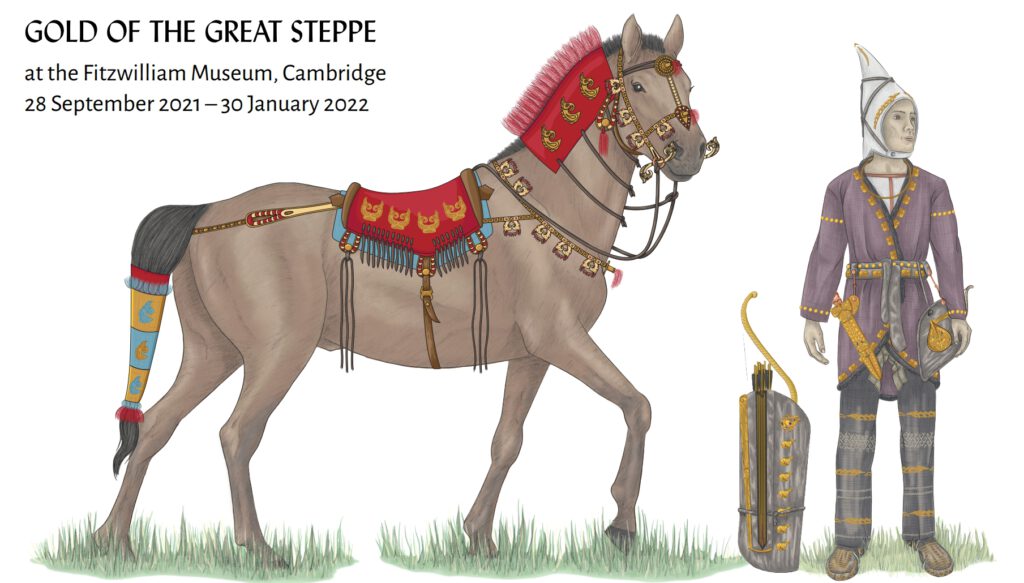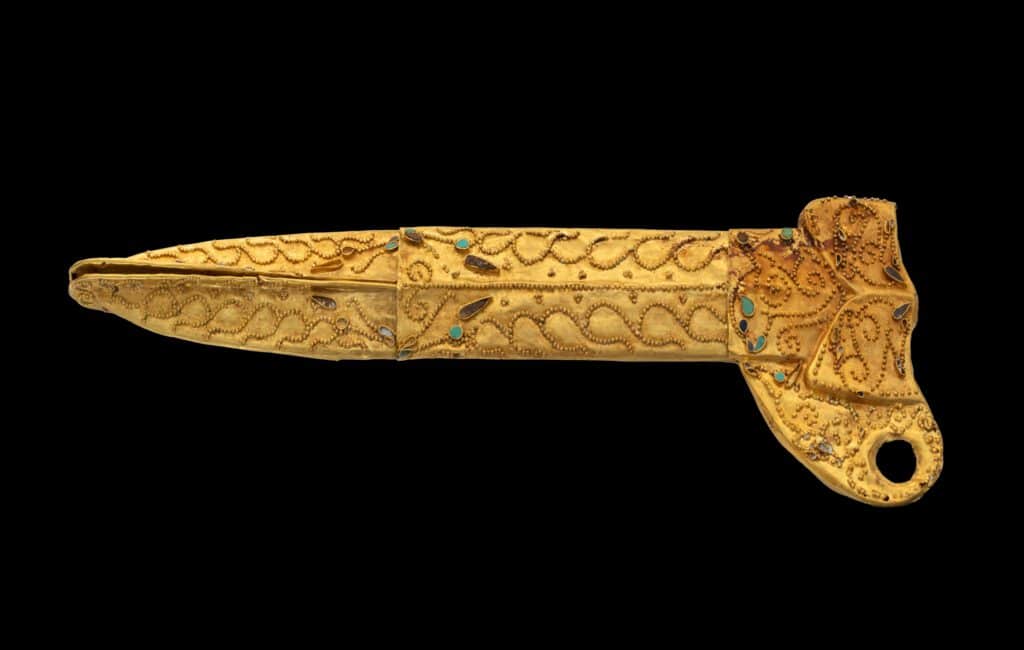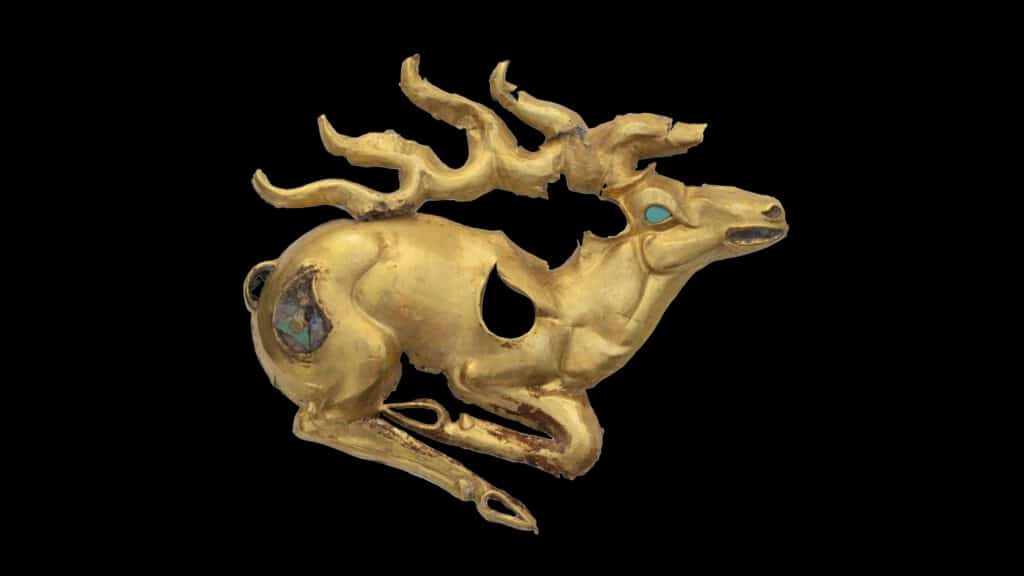Gold of the Great Steppe – a talk with Curator Dr. Rebecca Roberts
The exhibition Gold of the Great Steppe invites the public to dive into the world of the Saka who was magnificent goldsmiths at their time.
We had the opportunity to have an interview with Dr. Rebecca Roberts, the Project Curator of the exhibition Gold of the Great Steppe in Fitzwilliam Museum in Cambridge (UK) to talk about her first experiences with Kazakhstan, the exhibition itself and the newest discoveries about the Saka which lived around 2600 years ago in the territory what is nowadays Republic of Kazakhstan.
Info Shymkent: How are you, Rebecca? Where are you at the moment?
Dr. Rebecca Roberts: Thank you so much for sending me these questions, I am happy to answer them as best I can. I am currently in Cambridge, UK.
Info Shymkent: Can you introduce yourself to our readers, please?
Dr. Rebecca Roberts: I am an archaeologist at the McDonald Institute for Archaeological Research and the Fitzwilliam Museum, University of Cambridge. My research activities involve trying to understand how people interacted with the landscape and the plants around them in the Bronze and Iron ages in Central Asia (from around 3000 years ago), and also documenting and protecting cultural heritage and making it more accessible to members of the public and researchers in South Asia.
Info Shymkent: Your research focus is on East Kazakhstan. You wrote your PhD, Master of Letters and Bachelor of Arts about topics out from this region. Where is the interest came from? You went to Kazakhstan before as a tourist? Or just because of curiosity? Or via relatives?
Dr. Rebecca Roberts: I studied Archaeology and Anthropology for my undergraduate degree. At the end of our first year we were required to gain some field experience in archaeology. A friend and I found an archaeological field school in Kazakhstan on the internet, so we signed up. Then we had to go and buy a map to find out where Kazakhstan was (this was in 2002, so before Google Maps existed). I just fell in love with the country – the people, the archaeology, the landscape.

Info Shymkent: That is a gorgeous story. And how was your experience during your research time in Kazakhstan? What was the biggest challenges to live and work as an European researcher in Kazakhstan?
Dr. Rebecca Roberts: I’ve had such a wide range of experiences during my time spent in Kazakhstan over the years, from living for weeks in a tent in the Kyzyl Kum desert during excavations, to attending the ballet at the Abay State Opera House in Almaty. There is never a dull moment! I think the biggest challenge is to accept that I will always make some silly mistakes as a foreigner, from bringing the wrong gift to a house visit, to alighting at completely the wrong bus stop in the dark in the middle of winter. It has taught me that people are kind, that making the effort to learn local languages is always worth it, and that it is through mistakes that we learn how to do better next time.

Info Shymkent: You made deep research about the ancient Saka tribe – well known to many people by Queen Tomyris who defeated the Persian King Cyrus the Great – which lived around 3000 years ago in the large region between Black Sea and Siberia – Kazakhstan was just the centerpiece of this region. Can you tell us more about the Saka, please? What made them special for this time? Which discoveries you and your team could make over the last years? What you learned about the beliefs and social life of the Sakas?
Dr. Rebecca Roberts: The Saka were part of the pan-Scythian world which consisted of groups of people who shared common artistic traditions and ways of life which stretched across hundreds of kilometres, and endured for hundreds of years during the Iron Age. The Saka were among the earliest of the Scythian groups to emerge, and they came from the Altai region in the eastern part of the Eurasian steppe. My research into the Saka is just one contribution to a much larger network of researchers in the region, and I have been deeply immersed in reading the work of archaeologists from Central Asia who have spent many decades studying Saka material. For my own part, my research into Saka and Saka-Wusun lifeways in south-eastern Kazakhstan has found that they used the landscape in sophisticated ways, engaging in agriculture where it was profitable to do so, while also using pastoral nomadism as a highly efficient way of getting the most out of the ecological zones they occupied. Steppe, mountain pastures, forests, foothills, wetlands, semi-desert – the Saka seem to have adapted their way of life to a wide variety of different environments. They were an incredibly sophisticated people: hierarchical, resilient and complex in their material and social interactions. They marked the landscape with their large burial mounds – kurgans – which still dominate the landscape in many parts of Kazakhstan today.

Info Shymkent: Some of these items which was found in kurgans can be seen in the great exhibition Gold of the Great Steppe is running in Fitzwilliam Museum in Cambridge, UK from September till the end of January 2022. You are responsible for this exhibition as the project curator. Can you tell us more about the exhibition and the exhibition highlights?
Dr. Rebecca Roberts: The exhibition presents a great many very recent finds from excavations led by Kazakh archaeologists Zainolla Samashev and Abdesh Toleubayev, who have spent many decades studying Saka material. It is incredibly exciting to be able to introduce the British public to this important chapter in Eurasian history. The stars of the show are artifacts from the burial of a Saka youth, no older than 18 when he died, whose untouched grave was discovered in 2018 at the Eleke Sazy burial ground. This is only the second time an unlooted Saka grave has been discovered on the territory of Kazakhstan, the first being the discovery of the Golden Man in 1969. While his remains are safely in East Kazakhstan, visitors can see the items he was buried with, including a hefty gold torc that was placed around his neck, a gold-decorated quiver and scabbard, and thousands of tiny gold beads, each 1mm in diameter, which adorned his shoes. While the hundreds of gold objects in the exhibition are dazzling, as an archaeologist I am particularly happy that we also have artifacts from recent excavations at a Saka-period settlement such as a grinding stone and pottery, showing another side to these expert goldsmiths.
Info Shymkent: What was the biggest challenges to bring the Saka gold to the UK?
Dr. Rebecca Roberts: The entire exhibition was curated, designed, transported, built, and installed during the pandemic, and it is a testament to the dedication and passion of staff at the Fitzwilliam Museum and our lending museum, the East Kazakhstan Regional Museum of local history that we managed to bring it into being. As an example of the challenges we faced, there were no direct flights between the UK and Kazakhstan when the objects travelled to Cambridge. For me personally, editing the catalog, curating the artifacts to be displayed, and writing the labels and information panels while also homeschooling my young son during the lockdowns was a particular challenge. It was a labour of love, and I am so proud of everything we have achieved with this exhibition. It was such a huge team effort.

Info Shymkent: Huge congratulations that you achieved the logistics and organisations in these difficult times. But how is the response and feedback of the public to the Gold of the Great Steppe exhibition two months after opening? What were the greatest surprises for the visitors?
Dr. Rebecca Roberts: We have had an overwhelmingly positive response to the exhibition, making it all worthwhile. I think many people had no idea that Kazakhstan has such a rich (in every sense) history, and that the Saka people were so sophisticated and such an important part of our shared Eurasian story. Despite having to restrict numbers due to Covid, we have had many thousands of visitors, and it has been wonderful to hear that we also have people who come back to see it again! It is free to visit, and we hope that as many people as possible will take the opportunity to see this incredible material.
Info Shymkent: The Golden Man – a buried Saka warrior found in 1969 near Issyk – became a national symbol of Kazakhstan. There are many statues around the country and a copy is also currently on display in EXPO 2020 pavilion in Dubai. Are there intentions about further research on the Golden Man. You know – there are still ongoing discussion about the sex of the Golden Man – maybe a young Tomyris?
Dr. Rebecca Roberts: As far as I understand, the remains of Golden Man have now been reburied, after spending many years lost in storage. It is interesting to note that this individual was also a teenager, aged 16-18, as was the Saka youth discovered at Eleke Sazy in 2018. I should note here that the Eleke Sazy teenager was buried with a younger female relative – aged 13-14, whose grave was unfortunately almost completely looted save for a small bone weaving tablet found among her scattered bones. Some displaced gold artifacts found outside the burial chamber give a tantalizing hint that she, too, may have been just as richly adorned, and we know from other Scythian-era burials that women were also sometimes buried with weapons. I think we have much more to learn about the role of women in Saka society.
Info Shymkent: What are your plans for the future – after the exhibition? Do you want to do further research in Kazakhstan to reveal more answers about the Saka?
Dr. Rebecca Roberts: It has been a privilege to work with this material for the exhibition, and I would love to continue along this line of study with my colleagues in Kazakhstan. I am currently arranging for some radiocarbon dating to be undertaken on material from the most recent excavations. More importantly, my PhD student Saltanat Amir, who is from the East Kazakhstan region and assisted in curating the exhibition, is currently analyzing artifacts from the exhibition in our state-of-the-art laboratories here in Cambridge. We will then be sharing, analyzing, and co-publishing the new discoveries with our Kazakhstani colleagues. I am also excited about the next generation of scholars from Kazakhstan – current students and early career researchers – and the discoveries and interpretations they will bring in future. I hope we can establish strong research links between Cambridge and Kazakhstan that will endure long into the future.
Info Shymkent: Thank you very much for this detailed interview, Rebecca. We think it give to our readers new insights into the world of the ancient Sakas and to make them curious about the exhibition Gold of the Great Steppe in Cambridge. We wish you good luck and all the best for your ongoing research and we can’t wait to hear about the next great discoveries about the life of the Sakas.
Find more information about the exhibition Gold of the Great Steppe and Dr. Rebecca Roberts:
- Website about Gold of the Great Steppe exhibition
- Website of Fitzwilliam Museum – home of Gold of the Great Steppe exhibition
Important image information:
- Photo credit for header image of the article with the Kurgan goes to Yevgeniy Domashev/Instagram: megalara_garuda
- Copyright and image credits for all object photographs goes to Fitzwilliam Museum/East Kazakhstan Regional Museum of Local History
- Image credit for all drawings (Saka with horse): Vicki Herring/Fitzwilliam Museum



